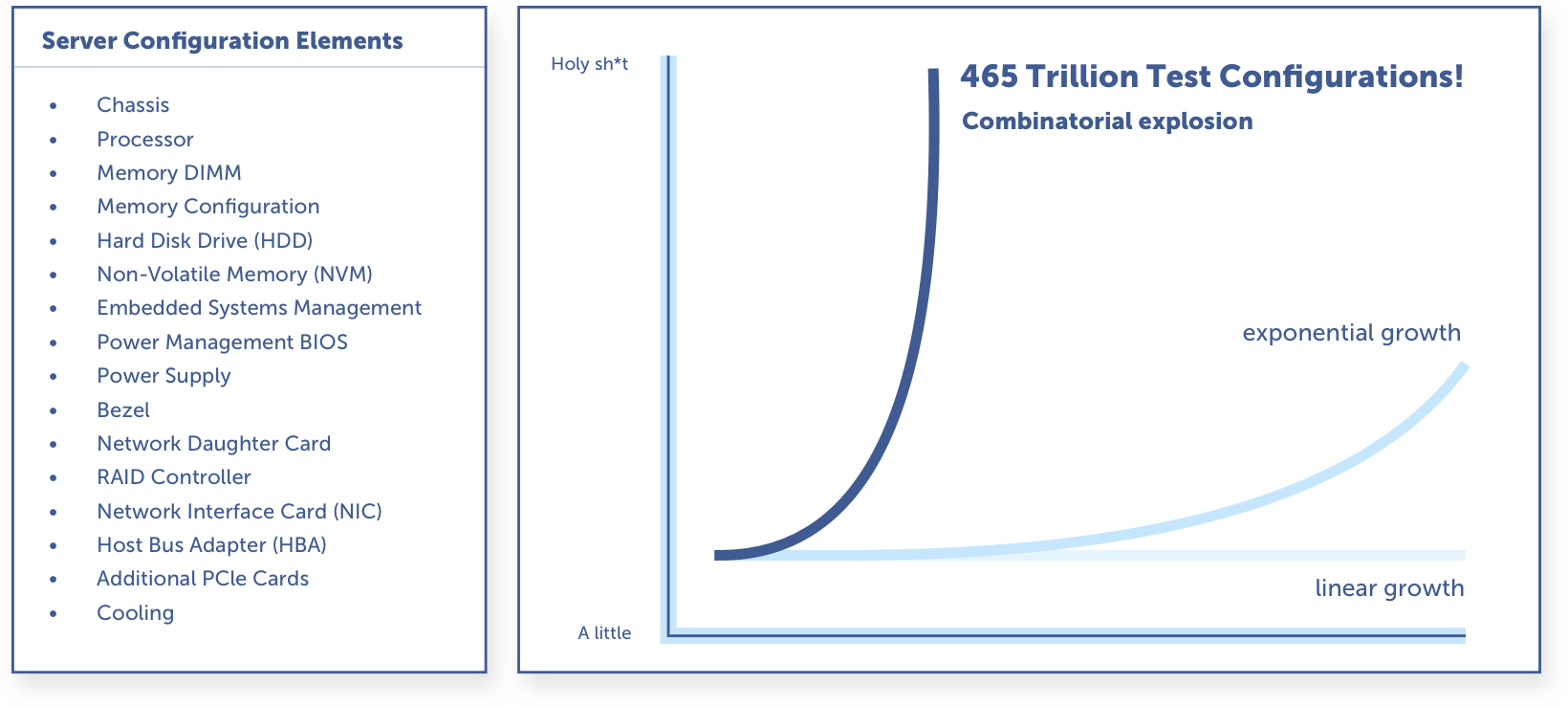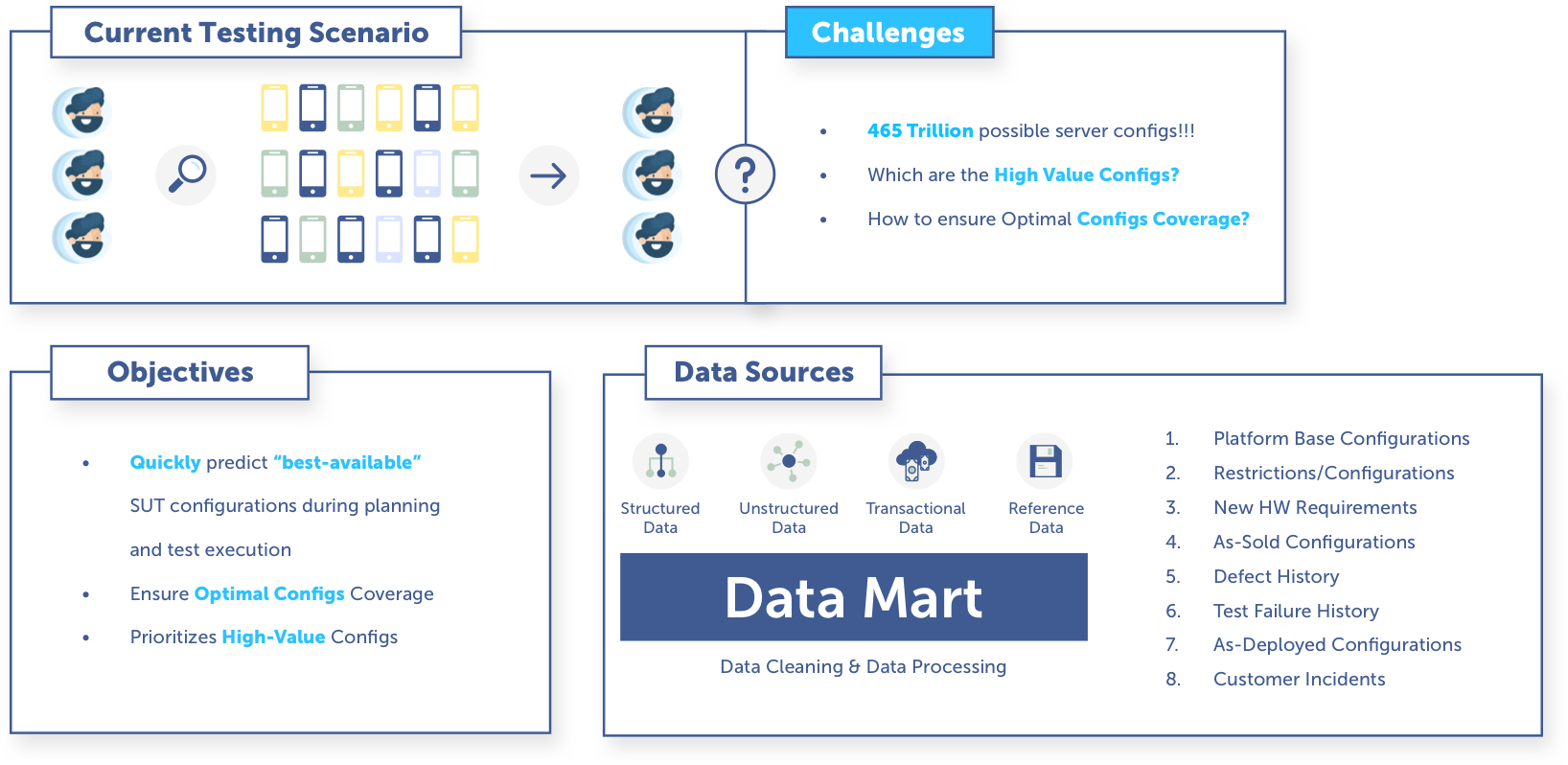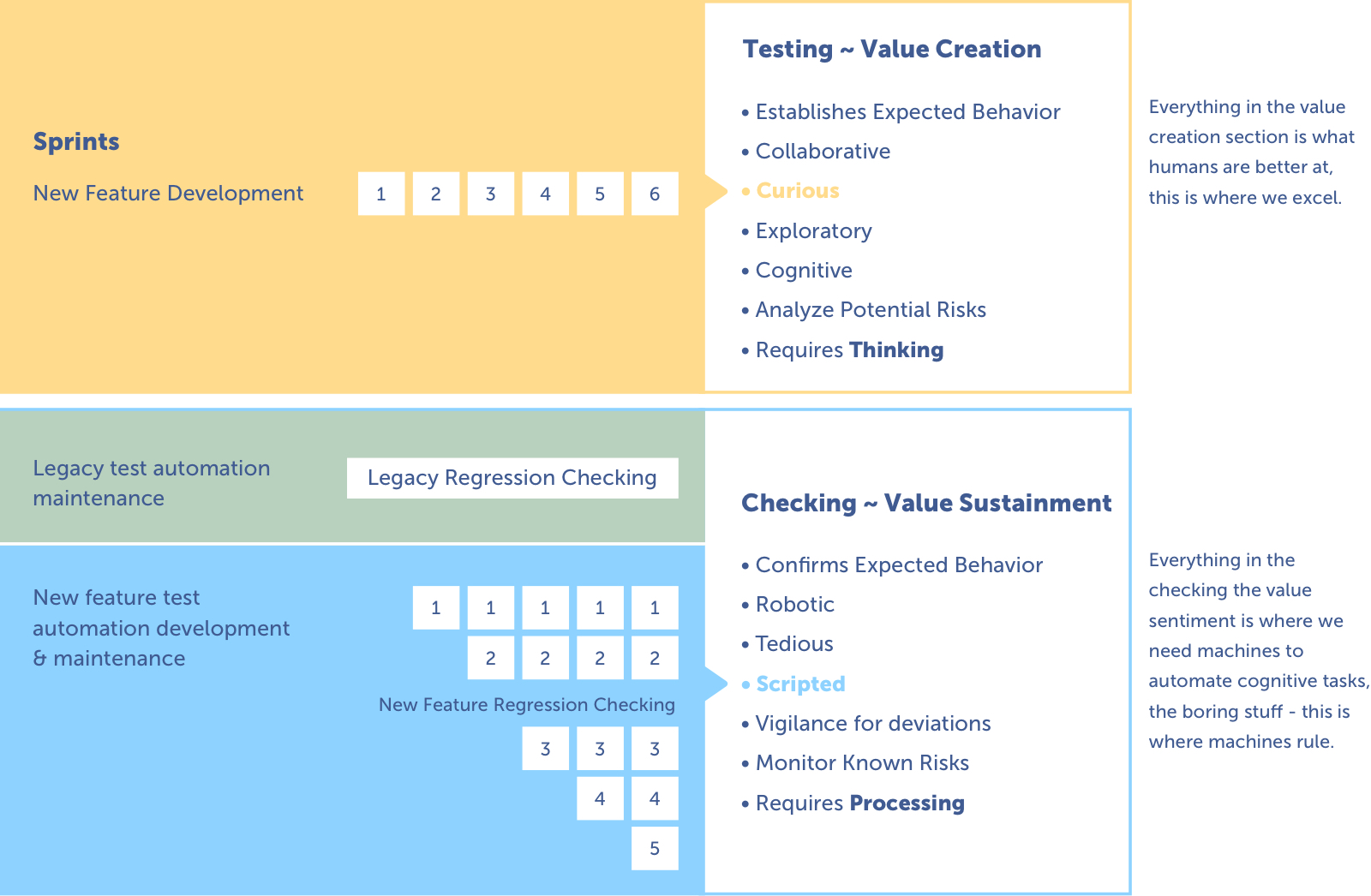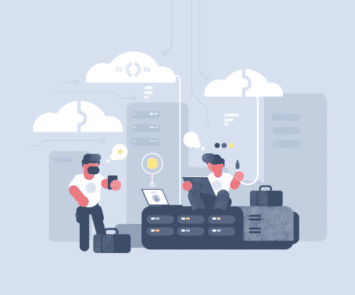
Testing practices have changed over the last four decades to keep up with technology and fast-paced software development. Today, companies are investing more in artificial intelligence (AI) and machine learning (ML) to stay ahead.
Software development is riddled with challenges and many are already developing AI-based solutions for those problems. This whitepaper was written by leading experts in AI and ML to bring you the latest technologies and innovations in the world of software quality.
This white paper will discuss:
- Today’s main challenges in releasing a high-quality product.
- How to use AI and ML to overcome these challenges.
- Where AI and ML can augment major dev and QA initiatives.
- What the future of software quality will look like.

Current Challenges in Releasing High-quality Products
In today’s fast-paced development environment, dev teams face a number of challenges in releasing high-quality products. They include data management challenges, time-based challenges, software moving back to the front end, QA bottlenecks in agile development, and the increasing number and diversity of mobile devices and apps.
Data Management Challenges
Today’s software development pipeline continuously generates massive amounts of data from multiple channels — data which must be taken into consideration during the QA decision-making process. This data includes test data (parameters and values to be used), environment data, and production data.
Although analyzing this constant stream of big data will provide software development teams with invaluable insight and visibility into factors affecting the velocity, quality, and efficiency of their software engineering processes and deliverables, human beings are incapable of processing and making sense of such huge amounts of information. However, disregarding this data will reduce team efficiency, increasing their likelihood of making mistakes.
Server Software Example

SUT Configuration Model

Time-Based Challenges
With agile driving the current software development process, dev teams have to code and deploy solutions faster than ever to meet market demands. As such, until the testing phase,they have little or no time to perform structural quality analysis or identify critical programming errors. Increasing release velocity and ensuring the delivery of high-quality software to clients require dev teams to do more with less, avoid waste, and shift testing to the left.
The adoption of agile also means that teams have to release applications in frequent incremental iterations. This results in builds that require continuous testing, which puts tremendous pressure on QA teams. To do their job properly, they would have to change on all fronts, starting with the tools and processes they use and then moving on to their skillsets and organizational structure.
QA: A Bottleneck in Agile Development
In the mid-1900s, it took approximately three years for dev teams to develop and deliver applications that could satisfactorily take care of clients’ business needs. This was referred to as the application development crisis. The advent of DevOps (continuous integration, delivery, testing, and so on) and agile reduced time to market by breaking down entire application releases into minimum viable features, enabling dev teams to deliver smaller bits of business value more quickly while reducing the risk of shipping something that will not get used because requirements change.
Dev teams collect user information, usage data, and feedback, and use these iteratively during production to improve the application over time. However, this means that developers, release engineers, and testers do most of their work post-production — a situation that most testers are uncomfortable with.
Software Moving Back to the Front End
The development of JavaScript frameworks such as React, Angular, etc., indicates that software has begun moving back to the front end. This makes code and business logic even harder to test since end-to-end testing on the front end is fragile, flaky, and breaks more often. Due to these factors, dev teams are reluctant to automate testing.
Also, the more teams shift left, the earlier they find bugs. As such, they are forced to write and run lots of integration tests for each software component — a task that is virtually impossible to do manually. This has caused QA to become more of a bottleneck in agile development.
Increase in the Number and Diversity of Mobile Devices and Apps
The explosion of the mobile app development space in recent years was caused by the increased use and development of a plethora of smartphone devices and tablets. The popularity of iOS on iPod, iPad, and iPhone devices and Android OS on most smartphones also prompted many manufacturers to create their own OS for smartphones and tablets, giving rise to systems like Firefox OS 2, Tizen, Ubuntu, and Windows phones.
Also, each of these OS’s came with their own SDKs (source development tools), which are used to develop native applications. With such a diverse number of devices and different OS versions to support, SDK peculiarities to keep track of, and the continuously evolving nature of the smartphone and mobile apps market, testing has become more complex and difficult on the mobile front.

How to Use AI and ML to Overcome Software Quality Challenges
When starting up a new software project, dev teams should understand that quality isn’t solely the responsibility of QA engineers or the QA team. It’s everyone’s responsibility. With this mindset governing how teams go about sprint planning and the rest of the software development process, organizations are better able to achieve successful, high-quality product releases.
Teams should also do all they can to stabilize the entire continuous testing workflow and ensure a mature DevOps pipeline. This would require continuous collection and analysis of data from relevant sources to better inform sprint planning and testing activities.
Leveraging Big Data and Smart Analytics Solutions
The analysis of the massive amounts of data generated by the software development pipeline can help teams overcome most software quality challenges, especially those related to testing. Though it’s easy to feel overwhelmed and stop collecting the data, software organizations should instead look for ways to make sense of the data and use it to their advantage.
A Deeper Look at Test Configurations
One of the methods that fast-paced development organizations can use to solve some of their software quality challenges is by using the data generated by end-users to inform their testing. This data is essential to testing activities since it can help dev teams determine what should be tested through the data-driven selection of test configurations and combinations.
The test configuration matrix in most dev environments can be massive, amounting to billions or trillions of unique configurations that testers must run through.
By leveraging big data and smart analytics solutions to take a deep look at the data sources from which these configurations are pulled, testing engineers can narrow down the number of configurations to those that really matter (i.e. those that end users/customers are actually deploying), as well as test case history and operational data.
Smart analytics solutions help dev teams and QA managers make more informed decisions on testing activities, resulting in improved product quality and increased velocity and efficiency of the entire software development process.
SeaLights’ Quality Intelligence Platform
The best solution is one that can apply real-time analytics to thousands of data items, test executions, insights, builds, code changes, and historical data from production to determine software release readiness. Such a solution should be able to analyze quality trends and the risks presented by code changes over time and present QA managers with accurate information (in real-time) to enable them to plan more efficient sprints.
![]()
This is where SeaLights’ Quality Intelligence Platform comes in. Test Gap Analytics (one of SeaLights’ functionalities) leverages big data analytics to help dev teams improve software quality by identifying what should be tested and areas where new test development should be executed. Test Gap Analytics works like a funnel in which each layer of information it provides is an additional prism that allows teams to focus attention on the areas of code that matter the most. In this instance, the first prism that is provided is test coverage, which is based on either a specific test type or all the different test types that are run on the application during testing. SeaLights is able to reveal the code coverage no matter which test framework is being used.
The second prism provides data on code modification. It identifies code that was modified either during a specific sprint or within any time period you choose. When the data provided by the two prisms overlap, the areas of code that are common to both are called test gaps, which are code areas that were modified or added recently and were not tested by any test type. These are the areas of code that matter the most and represent a much higher risk to software quality.
Since QA teams tend to test everything (leading to inefficiencies and waste of engineering and other resources), identifying test gaps helps them focus on areas that are more likely to contain bugs while ignoring other areas with confidence. In essence, this facilitates data-supported risk-based testing.
The third prism represents important areas of code. SeaLights’ production agent enables organizations to expose end user’ usage data. This data comes from production and represents which methods are used and which aren’t.
Combining all three prisms enables organizations to determine which files and methods in vital areas were modified but not tested.
How Testim Can Help
Testim.io is an AI-assisted test automation solution/platform that enables dev teams to overcome software quality challenges by addressing the following aspects of test automation:
- Authoring and execution
- Stability
- Reusability
- Extensibility
- Maintenance
- Troubleshooting
- Reporting
- CI/CD integration
Testim.io uses a hybrid approach to the authoring and execution of tests, simplifying the test automation process so that both technical and non-technical members of dev teams can collaborate and start writing automated tests quickly. It uses AI models to speed up the writing, execution, and maintenance of automated tests, enabling developers to rapidly write and execute tests on multiple web and mobile platforms.
Testim.io learns from every test execution, enabling it to self-improve the stability of test cases, which results in a test suite that doesn’t break on every code change. Hundreds of attributes are analyzed in real-time to identify each element vs. static locators and minimal effort is required to maintain these test cases. It also gives dev teams the ability to extend the functionalities of the platform using complex programming logic with JavaScript and HTML and simplifies the process of capturing and reporting bugs by integrating with popular bug tracking tools.
The platform possesses robust features that not only help to automate tests, but also take care of the other important aspects of testing. These aspects include the execution of tests locally and in the cloud (either in a private or third-party grid), integration with CI/CD systems, capturing logs and screenshots of test runs, and the delivery of detailed reporting on test runs with graphs, statistics, and other related information.
Perfecto Mobile
Perfecto is a leading provider of continuous testing solutions that enable mobile and desktop web application developers and testers to create reliable and stable test scripts, as well as to execute and leverage machine-learning algorithms to analyze the test results.
Perfecto offers an intelligent cloud and SaaS-based platform that hosts globally real smartphones, tablets, and desktop machines for efficient and high-scale test execution. The solution is highly secured, enterprise-grade, and fully integrated into the DevOps toolchain.
Testing vs. Checking
Iterative development


Measuring Software Quality in the AI World
There are a lot of metrics that are relevant to software quality. These metrics include test execution time, failure rates, and coverage areas as well as test coverage per product area, the number of open defects in each area, execution status, and so on. Others include how many hotfixes were created, the number of version regressions discovered in the field, customer satisfaction levels, net promoter score, and more.
Although all of these metrics are also relevant to the AI world, measuring them would generate a vast amount of information, most of which won’t necessarily help dev teams properly track the most important element of all: release quality status.
To solve this challenge, SeaLights provides organizations with a Quality Trend Intelligence Report, which wraps up (in an easy-to-consume way) several key quality development KPIs. The report also provides a key metric known as the quality score, which is a number between 0 and 10 that indicates the maturity level or quality status of an application.
An application’s quality score is calculated using a complex equation that combines several metrics or parameters together. SeaLight’s quality score is a new KPI that aggregates a lot of metrics together to form a single kind of absolute/universal metric that organizations can monitor to determine what’s most important to them.

The Future of Software Quality
The common theme surrounding the emergence of AI and ML in automated testing is one of continuous improvement. However, these initiatives are driven by people and supported by processes — a development that is preceded by a change in mindset and culture. As such, the advent of AI-assisted test automation has had a significant impact on software development culture, processes, and people.
With big data analytics facilitating the real-time analysis of the huge amounts of data being generated from the current software development pipeline (as well as data flowing in from customer environments and production sites), software organizations are changing their culture to make testing a data-first and a data-informed process.
The analysis of said data has helped dev teams identify what not to test. This has caused a huge shift in the cultural mindset of dev organizations, especially with regards to testing and development leads.
The Effects of AI on Testing Activities
Over the last decade, various developments such as the emergence of agile, DevOps, shifting left, shifting right, and the more recent integration of AI, ML, and analytics into software development activities have radically changed testing activities. Testers must learn and develop new skills and evolve their roles to fit in with emergent technologies and processes.
To avoid becoming obsolete, testers must become lifelong technology learners. They must learn to leverage emerging technologies and processes to deliver more value to their organizations.
Also, some organizations are working on implementing a “feature team structure.” Such a structure entails developers sitting in with QA engineers (now called dev testers) not only to plan activities that should be part of the next sprint but also to look at must-have testing/automation technical. By involving QA engineers in sprint planning and execution activities right from day one and making them part of the value creation team and process, software development organizations are better able to rapidly release higher quality products to clients and consumers.
Achieving such objectives would require embedding QA into the organization’s DNA through the implementation of practices like behavior-driven development, test-driven development, and so on.
The Role of QA Engineers in the Face of Recent Advancements in AI and ML
Recent advances in AI and machine learning technologies have facilitated the creation of test automation tools, solutions, and platforms that are slowly but surely making the traditional role of QA engineers obsolete. However, the impact of these technological advancements will be hardest on those who don’t learn to leverage emergent technologies or strive to improve their collaborative skills. Such individuals are usually adamant about using manual processes to execute tasks related to testing/regression testing.
What are our roles?

The Dawn of Cognitive Automation
Although most dev teams believe that the current age of automation and smart assistants will remove the need for human testers, there are certain areas where the skills of human QA engineers are indispensable. The widespread adoption of agile has created a growing pile of regression testing, whether dev teams are automating the legacy part of the app or automating all of the new features in the current release cycle.
Continuous testing is concerned with confirming expected behavior and looking out for any deviations or anomalies. Since these are tedious, repetitive, and robotic tasks, they are best left to automation solutions.
With the advent of AI and ML, software development organizations focused on automating these areas. This frees up valuable time that testers can use to concentrate on the most important part of testing (i.e. human thinking).
As such, development organizations are beginning to turn their attention to the cognitive aspect of testing or cognitive automation.
In agile teams, value creation occurs within the boundaries of the sprint. In this type of a collaborative environment, testers work to establish expected behavior during sprints. Their task is exploratory by nature and requires a lot of thinking and collaboration. These are the kinds of tasks that humans excel at and, coincidentally, where testing engineers are really needed.
The future role of QA engineers lies in the realm of cognitive testing and test case design and planning. Although QA teams can leverage AI and analytics to help them execute such tasks, the core functions of exploratory and cognitive testing are best performed by humans.
In essence, traditional QA roles must evolve in the face of recent advancements in AI and ML. QA engineers must learn to take advantage of the various test automation tools in the market and harness the power of smart analytics and artificial intelligence to deliver more value to the entire software development pipeline.
New Challenges in Software Development
As software development continues to evolve, organizations will encounter new challenges. What is currently happening is that organizations are trying to release applications more quickly, knowing that they are the first approximations rather than the final product. The software team (including software developers, test engineers, documentation people, release engineers, and so on) continually work on, improve, and stay with the application throughout the application lifecycle.
Although this may be slow in coming, the attitudes of software teams (whether DevOps or agile) are evolving to the point where the team takes responsibility for the application — not only for what it does on developer machines, build servers, and test environments, but also in production.
The Need for More Correlation Between Testing and Production
QA has now become a big part of software development and the business goals of software development organizations. As such, it affects everything from specs and design all the way to the enterprise.
Ultimately, the success of software development will be measured by end-users and clients, and how they experience the application. This will create a need for more correlation between testing and production, which would make tests even more stable.
By leveraging AI and machine learning to analyze production data, dev teams can better understand what is happening, enabling tests to become more stable and smarter (with smart locators).
The Need for a Continuous Monitoring Environment
Previous years witnessed the transition of software development into agile, continuous testing, DevOps, and test automation. Presently, we’re beginning to move into the age of cognitive automation. Although automating most checking activities have enabled software organizations to focus more on the value creation process, it has created new challenges.
There will come a time when there are so many automated processes running in the background that organizations will be forced put in place very effective continuous monitoring solutions on both the pre-release and customer environments. These solutions must also monitor the data sources that collate the information that is fed to the AI systems, as well as the systems that generate testing results. In essence, there will be so much automation going on that software organizations willneed to put in place a continuous monitoring environment.
FInally, there is the challenge of actually testing the new software that is being built with the assistance of AI and machine learning. The World Quality Report shows that the industry is massively adopting AI and machine learning capabilities in order to provide better software and create new offerings.
Since such capabilities differ from the tools being used to provide more value to QA, testers must look for a way to test the quality of applications developed with the assistance of AI and machine learning. Resolving this challenge would require testers and QA teams to review the tools they are using, update the skillsets they bring to the table, and look for a viable solution to this new reality.
Conclusion: Improve software quality challenges through test automation and analytics
Improving software quality in the face of the challenges brought about by recent technological advancements and the fastpaced nature of current software development practices requires dev teams to leverage AI-based solutions. AI and ML can help augment major dev and QA initiatives through test automation and the real-time analysis of thousands of data items, test executions, insights, builds, code changes, and historical data from production to determine software release readiness.
By automating testing and providing QA teams with relevant insights based on actual data from the software development pipeline, AI and big data analytics can help organizations develop and deliver higher quality products to clients.





